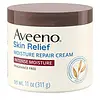What's inside
What's inside
 Key Ingredients
Key Ingredients

 Benefits
Benefits

 Concerns
Concerns

 Ingredients Side-by-side
Ingredients Side-by-side

Water
Skin ConditioningGlycerin
HumectantDistearyldimonium Chloride
Petrolatum
EmollientIsopropyl Palmitate
EmollientCetyl Alcohol
EmollientDimethicone
EmollientAvena Sativa Kernel Flour
AbrasiveAvena Sativa Kernel Oil
Skin ConditioningAvena Sativa Kernel Extract
AbrasiveButyrospermum Parkii Butter
Skin ConditioningCaprylyl Glycol
EmollientPhenoxyethanol
PreservativeSteareth-20
CleansingSodium Chloride
MaskingWater
Skin ConditioningCarthamus Tinctorius Seed Oil
MaskingC12-15 Alkyl Benzoate
AntimicrobialCaprylic/Capric Triglyceride
MaskingPersea Gratissima Oil
Skin ConditioningCetearyl Alcohol
EmollientRicinus Communis Seed Oil
MaskingAvena Sativa Kernel Flour
AbrasiveGlyceryl Distearate
EmollientButyrospermum Parkii Butter
Skin ConditioningDistearyldimonium Chloride
Phenoxyethanol
PreservativeBenzyl Alcohol
PerfumingTocopheryl Acetate
AntioxidantPanthenol
Skin ConditioningDimethicone
EmollientDisodium EDTA
Water, Carthamus Tinctorius Seed Oil, C12-15 Alkyl Benzoate, Caprylic/Capric Triglyceride, Persea Gratissima Oil, Cetearyl Alcohol, Ricinus Communis Seed Oil, Avena Sativa Kernel Flour, Glyceryl Distearate, Butyrospermum Parkii Butter, Distearyldimonium Chloride, Phenoxyethanol, Benzyl Alcohol, Tocopheryl Acetate, Panthenol, Dimethicone, Disodium EDTA
Ingredients Explained
These ingredients are found in both products.
Ingredients higher up in an ingredient list are typically present in a larger amount.
Oatmeal flour is created by grinding down the kernels of oats. Oatmeal helps sooth, hydrate, and protect the skin.
Oatmeal kernel flour has abrasive, or exfoliating, properties.
Learn all about the skin benefits of colloidal oatmeal here.
Learn more about Avena Sativa Kernel FlourThis ingredient is also known as shea butter. It is an effective skin hydrator and emollient.
Emollients help soothe and soften your skin. It does this by creating a protective film on your skin. This barrier helps trap moisture and keeps your skin hydrated. Emollients may be effective at treating dry or itchy skin.
Shea butter is rich in antioxidants. Antioxidants help fight free-radicals, or molecules that may harm the body. It is also full of fatty acids including stearic acid and linoleic acid. These acids help replenish the skin and keep skin moisturized.
While Shea Butter has an SPF rating of about 3-4, it is not a sunscreen replacement.
Shea butter may not be fungal acne safe. We recommend speaking with a professional if you have any concerns.
Learn more about Butyrospermum Parkii ButterDimethicone is a type of synthetic silicone created from natural materials such as quartz.
What it does:
Dimethicone comes in different viscosities:
Depending on the viscosity, dimethicone has different properties.
Ingredients lists don't always show which type is used, so we recommend reaching out to the brand if you have questions about the viscosity.
This ingredient is unlikely to cause irritation because it does not get absorbed into skin. However, people with silicone allergies should be careful about using this ingredient.
Note: Dimethicone may contribute to pilling. This is because it is not oil or water soluble, so pilling may occur when layered with products. When mixed with heavy oils in a formula, the outcome is also quite greasy.
Learn more about DimethiconeDistearyldimonium Chloride is an antistatic agent and a surfactant.
Phenoxyethanol is a preservative that has germicide, antimicrobial, and aromatic properties. Studies show that phenoxyethanol can prevent microbial growth. By itself, it has a scent that is similar to that of a rose.
It's often used in formulations along with Caprylyl Glycol to preserve the shelf life of products.
Water. It's the most common cosmetic ingredient of all. You'll usually see it at the top of ingredient lists, meaning that it makes up the largest part of the product.
So why is it so popular? Water most often acts as a solvent - this means that it helps dissolve other ingredients into the formulation.
You'll also recognize water as that liquid we all need to stay alive. If you see this, drink a glass of water. Stay hydrated!
Learn more about Water